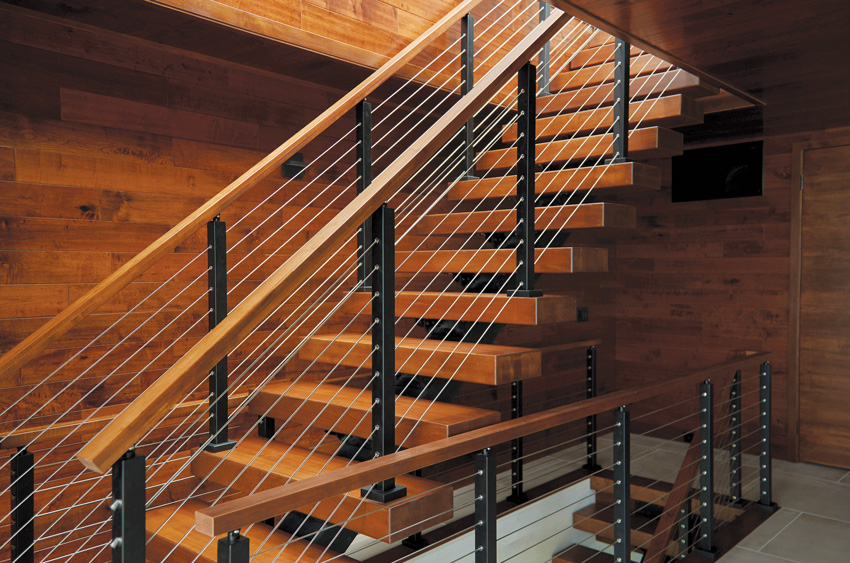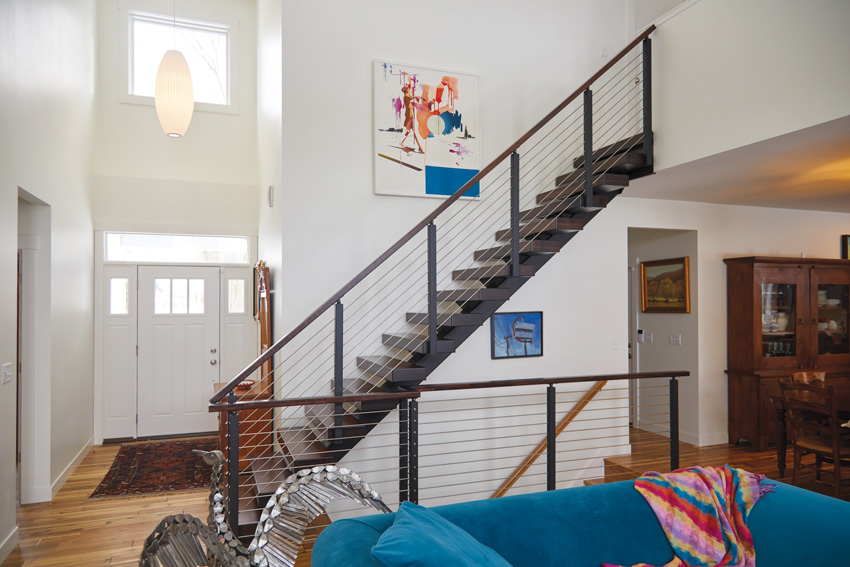The Beautiful, Modern, Budget-Friendly Floating Staircase
Learning Objectives:
- Explain the differences between floating and conventional staircases that enable floating staircases to allow people to safely travel between floors while requiring a much smaller footprint, supporting open-area design, and preserving views to the outdoors instead of obstructing them.
- Describe the floating staircase configurations that are available to meet the unique elevation and available space requirements of a project.
- List the International Building Code (IBC) criteria that the design of a floating staircase must satisfy to be considered code compliant.
- Compare the design approaches of using a local metal fabricator vs. a manufacturer to produce a floating stair system, and discuss the implications on the design process, delivery timeline, and ease of installation.
Credits:
This course is approved as a Structured Course
This course can be self-reported to the AANB, as per their CE Guidelines
Approved for structured learning
Approved for Core Learning
This course can be self-reported to the NLAA
Course may qualify for Learning Hours with NWTAA
Course eligible for OAA Learning Hours
This course is approved as a core course
This course can be self-reported for Learning Units to the Architectural Institute of British Columbia
There is a common misconception in the marketplace that dramatic, beautiful, and unique staircases must be expensive, time intensive, and complicated to incorporate into an interior. While, historically, staircases of note have been large, sweeping, architectural wonders constructed in marble or mahogany, today, contemporary design demands interiors that are streamlined and stripped back, so staircases have been revamped and redesigned to contribute to this minimalistic aesthetic. In the process, manufacturers created modern staircase solutions that could offer a simplified design process, be produced quickly, feature stunning materials, and be easily installed in as little as one day. The result of these streamlining and engineering efforts is a new type of modern staircase that satisfies mid-market project budgets in the commercial and residential space and offers a more attractive alternative to the concrete or drywall-encased stairways that so often find themselves hidden on the perimeter of a building.

All photos courtesy of Viewrail
“In the past, it has taken us weeks to months to pull together a stair system as elegant as this one,” says Lowell Smith of Dunes Development. “On the first flight of stairs, we had a bit of a learning curve, and it took us all of two days. We installed the second flight of floating stairs in one day.”
This new type of modern staircase creates drama and visual interest with air and openness and features a footprint so small, and structural supports that are so hidden, that the element practically floats in the space, which may explain how it came to be named a floating staircase.
The Anatomy of a Floating Staircase
A floating staircase is, essentially, an aesthetically deconstructed staircase, where the extraneous parts and pieces have been removed to reveal the basic components a staircase must possess to enable people to climb and descend safely throughout a space. The entire floating stair system is comprised of four key elements: a mono stringer, treads, brackets, and the railing system.

Floating staircases are modern solutions that can be produced quickly, installed in as little as one day, and feature stunning materials.
Instead of using two stringers to support the staircase on its right and left sides, which is the approach most commonly found in commercial and residential construction today, a floating staircase uses a single, central stringer for the necessary support. This type of stringer is referred to as a mono stringer. The mono stringer is a heavy-duty, mild steel tube that serves as the central beam running underneath the stairs from the top to the bottom of the staircase. One mono stringer supports one flight of stairs.
The use of one central stringer, instead of two stringers that flank the length of the staircase, eliminates the need for many of the finishing elements that are typically used to make the more visible stringers running alongside each staircase more aesthetically appealing. For example, a floating staircase does not need stringer fascia, the finished inside vertical surface of the stringer, or stringer capping, the finished surface that runs along the top of the stringer.
The treads are the horizontal surfaces of the stair, which provide the surface on which people step as they go up and down. Traditionally, stairs have been constructed with treads providing horizontal surfaces and risers providing the vertical surface between each tread. The tread-riser-tread-riser-tread-riser configuration creates that completed ribbon appearance that most stairs possess. Floating staircases do not include risers, allowing each tread to stand alone and enabling space, air, and view to travel through and around the staircase. Each tread is then fastened securely to the mono stringer with a bracket.
The last component of the floating staircase is the railing system. The railing system is constructed of the handrail, posts, and infill. The handrail is the part of the railing system that a person holds as while walking up or down a stair. The posts are the vertical structures that connect the handrail to the staircase and provide the support necessary to withstand the lateral force applied to the handrail when a person uses it. In a floating staircase, the posts are installed either directly into the treads or attached to the side of them. The infill is the material that fills in the open space between the posts and the treads and the handrail, creating a safety barrier along the staircase.
Railing systems have been built from a variety of materials over the years and constructed with varying degrees of detail, depending upon the application. The most distinguishing factor about the infills used in floating staircases is that, while meeting safety requirements, they offer an incredible openness that allows light and views to travel unobstructed throughout an interior. Commonly constructed from cables, rods, or glass, these materials create beautiful, effective, and modern railing systems that do not have visual barriers that break up a room.
The Aesthetic Difference: Floating vs. Conventional
The combination of the mono stringer, stand-alone treads, brackets, and transparent railing system used in the floating staircase creates a minimal and modern aesthetic that is dramatically different from the fully encased appearance so often created with conventional staircases. Conventional staircases are regularly designed to appear as if they are nestled into the larger building.

Floating staircases do not include risers, which allows light and view to travel through and around the dramatic structure.
This may have occurred as a result of the types of materials commonly being used to build the staircases and not because it creates optimal staircases.
In a typical construction project designed with typical staircases, the stringers, treads, and risers are made from the same plywood or lumber used to create the frame of the structure. When the stringers, treads, and risers are made from these lower-quality materials, they need to be covered up to make way for the desired aesthetic that will be created in the space. Just as drywall is used to cover up the wooden studs in the frame, the two unsightly stringers providing a border on either side of the staircase and the wood treads and risers must be camouflaged or finished. Contractors will often hide the lackluster materials used in stair construction by building up walls underneath the stairs with drywall so that visitors in the space never see the underside of the stairs. Then carpet or hardwood trim is applied to the top of the stairs to finish them.
Unfortunately, creating interior walls for the sole purpose of hiding the materials in a staircase has many undesirable results. It creates a staircase with a footprint that is much larger than it needs to be. The solid wall camouflage also breaks up the room unnecessarily and contradicts the minimalist, open-area aesthetic that is becoming so popular in commercial and residential spaces.
The floating staircase strips the staircase elements back to the necessities and then uses beautiful, high-quality materials to build them. Instead of stringers, treads, and risers made from plywood or framing lumber, a floating staircase is constructed with a powder-coated steel stringer, which is hidden beneath the treads, and thick wood treads in several on-trend and inspiring colors and finishes. There are no risers, and the railing systems are minimalistic and high quality as well, keeping stair users safe.
Floating stairs can be incorporated into a floorplan without creating a visual or physical obstruction in the space and requiring a fraction of the footprint consumed by more conventional drywalled staircases. The high-quality and beautiful materials do not require camouflage or extra structures to hide. People can see and walk under the stairs without losing contact with the larger room.
















